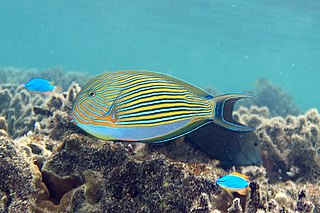
The lineated woodpecker is a very large woodpecker which is a resident breeding bird from Mexico south to northern Argentina and on Trinidad.

The white-lined broad-nosed bat is a bat species from South America. It is found in southern and eastern Brazil, Paraguay, Uruguay, northern Argentina, Bolivia, Peru, Ecuador, Colombia, French Guiana and Suriname.

The lined catshark or banded catshark is a species of catshark, belonging to the family Scyliorhinidae. It is found in the waters off the coasts of Beira, Mozambique, to East London, and South Africa between latitudes 19°S and 31°S, from the surface to 290 m. It can grow up to 56 cm in length.

Acanthurus lineatus, the lined surgeonfish, is a member of the family Acanthuridae, the surgeonfishes. Other common names include blue banded surgeonfish, blue-lined surgeonfish, clown surgeonfish, pyjama tang, striped surgeonfish, and zebra surgeonfish.

Euthynnus lineatus, the black skipjack or black skipjack tuna, is a species of ray-finned bony fish in the family Scombridae. It belongs to the tribe Thunnini, better known as the tunas.

Surface wave detection by animals is the process by which animals, such as surface-feeding fish are able to sense and localize prey and other objects on the surface of a body of water by analyzing features of the ripples generated by objects' movement at the surface. Features analyzed include waveform properties such as frequency, change in frequency, and amplitude, and the curvature of the wavefront. A number of different species are proficient in surface wave detection, including some aquatic insects and toads, though most research is done on the topminnow/surface killifish Aplocheilus lineatus. The fish and other animals with this ability spend large amounts of time near the water surface, some just to feed and others their entire lives.

Zographus regalis is a species of beetle belonging to the family Cerambycidae.

Zographus oculator, the Orange-eyed Long-horn Beetle, is a species of flat-faced longhorn beetles belonging to the family Cerambycidae.

The red-shouldered hawk is a medium-sized hawk. Its breeding range spans eastern North America and along the coast of California and northern to northeastern-central Mexico. Red-shouldered hawks are permanent residents throughout most of their range, though northern birds do migrate, mostly to central Mexico. The main conservation threat to the widespread species is deforestation.
Sternotomini is a tribe of longhorn beetles of the Lamiinae subfamily. It was described by Thomson in 1860.
Zographus aulicus is a species of beetle in the family Cerambycidae. It was described by Bertoloni in 1849. It has a wide distribution in Africa.
Zographus cingulatus is a species of beetle in the family Cerambycidae. It was described by Per Olof Christopher Aurivillius in 1913. It is known from the Democratic Republic of the Congo, Angola, and Malawi.
Zographus hieroglyphicus is a species of beetle in the family Cerambycidae. It was described by Carl Eduard Adolph Gerstaecker in 1855. It is known from Tanzania, Malawi, Kenya, and Mozambique.
Zographus nitidus is a species of beetle in the family Cerambycidae. It was described by Per Olof Christopher Aurivillius in 1914, originally Quimalanca. It is known from Uganda and the Democratic Republic of the Congo.
Zographus niveipectus is a species of beetle in the family Cerambycidae. It was described by Quedenfeldt in 1888, originally under the genus Sternotomis. It is known from the Central African Republic, Zambia, and the Democratic Republic of the Congo.
Zographus niveisparsus is a species of beetle in the family Cerambycidae. It was described by Louis Alexandre Auguste Chevrolat in 1844, originally under the genus Sternotomis. It is known from South Africa, Mozambique, and Zimbabwe.
Zographus plicaticollis is a species of beetle in the family Cerambycidae. It was described by James Thomson in 1868. It is known from South Africa and Namibia.
Zographus pulverulentus is a species of beetle in the family Cerambycidae. It was described by Nonfried in 1906, originally as a varietas of Zographus aulicus. It is known from the Democratic Republic of the Congo and South Africa.
Zographus quadrimaculatus is a species of beetle in the family Cerambycidae. It was described by E. Forrest Gilmour in 1956. It is known from Tanzania.
Zographus scabricollis is a species of beetle in the family Cerambycidae. It was described by Quedenfeldt in 1882, originally under the genus Quimalanca. It has a wide distribution in Africa.











